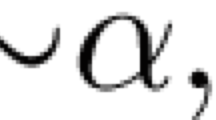Abstract
Two intuitionistic paradefinite logics N4C and N4C+ are introduced as Gentzen-type sequent calculi. These logics are regarded as a combination of Nelson’s paraconsistent four-valued logic N4 and Wansing’s basic constructive connexive logic C. The proposed logics are also regarded as intuitionistic variants of Arieli, Avron, and Zamansky’s ideal paraconistent four-valued logic 4CC. The logic N4C has no quasi-explosion axiom that represents a relationship between conflation and paraconsistent negation, but the logic N4C+ has this axiom. The Kripke-completeness and cut-elimination theorems for N4C and N4C+ are proved.
Similar content being viewed by others
Change history
04 August 2020
The original version of this article unfortunately contains several errors introduced by the typesetter during the publishing process. It has been corrected.
References
Almukdad, A., & Nelson, D. (1984). Constructible falsity and inexact predicates. Journal of Symbolic Logic, 49(1), 231–233.
Angell, R. (1962). A propositional logics with subjunctive conditionals. Journal of Symbolic Logic, 27, 327–343.
Arieli, O., & Avron, A. (1996). Reasoning with logical bilattices. Journal of Logic Language and Information, 5, 25–63.
Arieli, O., & Avron, A. (1998). The value of the four values. Artificial Intelligence, 102(1), 97–141.
Arieli, O., & Avron, A. (2016). Minimal paradefinite logics for reasoning with incompleteness and inconsistency. In Proceedings of the 1st international conference on formal structures for computation and deduction (FSCD), Leibniz International Proceedings in Informatics (LIPIcs), (Vol. 52 pp. 7:1-7:15).
Arieli, O., & Avron, A. (2017). Four-valued paradefinite logics. Studia Logica, 105(6), 1087–1122.
Arieli, O., Avron, A., & Zamansky, A. (2011). Ideal paraconsistent logics. Studia Logica, 99(1-3), 31–60.
Avron, A., Arieli, O., & Zamanskey, A. (2018). Theory of effective propositional paraconsistent logics, Studies in Logic (Mathematical Logic and Foundations) (Vol. 75, p. 550). Oxford: College Publications.
Belnap, N.D. (1977). A useful four-valued logic. In Epstein, G., & Dunn, J.M. (Eds.) Modern uses of multiple-valued logic (pp. 5–37). Dordrecht: Reidel.
Belnap, N.D. (1977). How a computer should think. In Ryle, G. (Ed.) Contemporary aspects of philosophy (pp. 30–56). Stocksfield: Oriel Press.
Béziau, J.Y. (2009). Bivalent semantics for De Morgan logic (The uselessness of four-valuedness). In Carnieli, W.A., Coniglio, M.E., & D’Ottaviano, I.M. (Eds.) The many sides of logic (pp. 391–402). Oxford: College Publications.
De, M., & Omori, H. (2015). Classical negation and expansions of Belnap-Dunn logic. Studia Logica, 103(4), 825–851.
Dunn, J.M. (1976). Intuitive semantics for first-degree entailment and coupled trees. Philosophical Studies, 29(3), 149–168.
Gabbay, D.M., & Wansing, H. (Eds.). (1999). What is negation? Applied Logic Series 13. Norwell: Kluwer Academic Publishers.
Gentzen, G. (1969). Collected papers of Gerhard Gentzen. In Szabo, M.E. (Ed.) Studies in logic and the foundations of mathematics, North-Holland (English translation).
Gurevich, Y. (1977). Intuitionistic logic with strong negation. Studia Logica, 36, 49–59.
Horn, L.R., & Wansin, H. (2017). Negation. In Zalta, E.N. (Ed.) The Stanford Encyclopedia of Philosophy (Spring 2017 Edition). https://plato.stanford.edu/archives/spr2017/entries/negation/.
Kamide, N. (2015). Trilattice logic: an embedding-based approach. Journal of Logic and Computation, 25(3), 581–611.
Kamide, N. (2017). Extending ideal paraconsistent four-valued logic. In Proceedings of the 47th IEEE international symposium on multiple-valued logic (ISMVL 2017) (pp. 49–54).
Kamide, N., & Shramko, Y. (2017). Embedding from multilattice logic into classical logic and vice versa. Journal of Logic and Computation, 27(5), 1549–1575.
Kamide, N., & Wansing, H. (2012). Proof theory of Nelson’s paraconsistent logic: a uniform perspective. Theoretical Computer Science, 415, 1–38.
Kamide, N., & Wansing, H. (2015). Proof theory of N4-related paraconsistent logics. In Studies in logic, (Vol. 54 pp. 1–401). London: College Publications.
Kamide, N., & Zohar, Y. (2019). Yet another paradefinite logic: the role of conflation. Logic Journal of the IGPL, 27(1), 93–117.
McCall, S. (1966). Connexive implication. Journal of Symbolic Logic, 31, 415–433.
Nelson, D. (1949). Constructible falsity. Journal of Symbolic Logic, 14, 16–26.
Omori, H., & Wansing, H. (2015). A web site on connexive logic. https://sites.google.com/site/connexivelogic/home.
Priest, G. (2002). Paraconsistent logic. In Gabbay, D., & Guenthner, F. (Eds.) Handbook of philosophical logic. 2nd edn., (Vol. 6 pp. 287–393). Dordrecht: Kluwer Academic Publishers.
Rautenberg, W. (1979). Klassische und nicht-klassische Aussagenlogik. Braunschweig: Vieweg.
Shramko, Y. (2016). Truth, falsehood, information and beyond: the American plan generalized. In Bimbo, K. (Ed.) J. Michael Dunn on information based logics, outstanding contributions to logic, (Vol. 8 pp. 191–212). Berlin: Springer.
Shramko, Y., & Wansing, H. (2005). Some useful sixteen-valued logics: how a computer network should think. Journal of Philosophical Logic, 34, 121–153.
Takeuti, G. (2013). Proof theory, 2nd edn. New York: Dover Publications, Inc. Mineola.
Vorob’ev, N.N. (1952). A constructive propositional calculus with strong negation (in Russian). Doklady Akademii Nauk SSSR, 85, 465–468.
Wansing, H. (1993). The logic of information structures. Lecture Notes in Artificial Intelligence, 681, 163.
Wansing, H. (2005). Connexive modal logic. Advances in Modal Logic, 5, 367–385.
Wansing, H. (2014). Connexive logic, Stanford Encyclopedia of Philosophy. http://plato.stanford.edu/entries/logic-connexive/.
Wansing, H., & Odintsov, S.P. (2016). On the methodology of paraconsistent logic. In Logical studies of paraconsistent reasoning in science and mathematics. Trends in Logic Book Series (pp. 175–204). Berlin: Springer.
Wansing, H., Omori, H., & Ferguson, T.M. (2016). Special issue: connexive logics. IfCoLog Journal of Logics and their Applications, 3(3).
Acknowledgments
We would like to thank the anonymous referees for their valuable comments. This research was supported by JSPS KAKENHI Grant Numbers JP18K11171, JP16KK0007, and JSPS Core-to-Core Program (A. Advanced Research Networks).
Author information
Authors and Affiliations
Corresponding author
Additional information
Publisher’s Note
Springer Nature remains neutral with regard to jurisdictional claims in published maps and institutional affiliations.
Rights and permissions
About this article
Cite this article
Kamide, N. Kripke-Completeness and Cut-elimination Theorems for Intuitionistic Paradefinite Logics With and Without Quasi-Explosion. J Philos Logic 49, 1185–1212 (2020). https://doi.org/10.1007/s10992-020-09553-w
Received:
Accepted:
Published:
Issue Date:
DOI: https://doi.org/10.1007/s10992-020-09553-w



